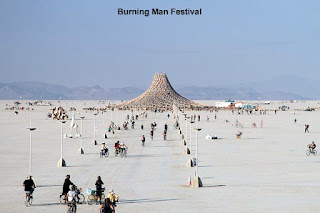Every year, thousands of pilgrims gather at the Neolithic Stonehenge monument in Wiltshire, England to celebrate the summer solstice. Thousands more trek to Nevada's Burning Man Festival to burn a towering effigy and the hopeful ill journey to Lourdes, France seeking a cure as they have for centuries. Although pilgrimage may seem an antiquated religious ritual, it remains a vibrant activity in a modern world of gadgets and instant gratification. As increasing numbers of us seek refuge from the demands of modern life and its electronic distractions, venturing to a sacred place in search of spirituality has never seemed more appealing. That pilgrimage continues to exercise such a strong attraction is testimony to the power it continues to hold for those who undertake these sacred journeys.
Pilgrimage is broadly defined as an outward journey of a religious or spiritual nature, typically to a shrine, temple, site or rite of significance to those of a particular faith or belief system. There are pilgrimages associated with all the world's spiritual traditions. Perhaps best known is the Hajj, an annual journey to Mecca considered one of the five pillars of Islam. Another famous pilgrimage is the Camino de Santiago, a journey made by Christians to the shrine that houses the remains of the apostle Saint James in Galicia in northwestern Spain. Jews make pilgrimage to the Temple Mount in Jerusalem, while Tibetan Buddhist, Hindus and Jains circumambulate Mount Kailash, the holiest mountain in the Himalayas. Every 12 years, Hindus in India gather at one of four sites along the Ganges river in what is known as the Kumbh Mela, considered the single largest gathering of human beings in one place on the planet.
The purposes for undertaking a shamanic or religious pilgrimage traditionally range from fulfilling a spiritual vow, finding or deepening one's faith, seeking a remedy for physical or spiritual problems, requesting guidance from spirits or deities of Nature, undergoing initiation rituals, paying homage, to realigning with one's innermost purpose and passion. For many, pilgrimage is a way to mitigate and resolve karma, the sum of a person's actions in this and previous states of existence, viewed as deciding their fate in future existences. Undoubtedly pilgrimage benefits those best equipped to receive its effects, pilgrims with a developed meditation ability, an unfolded responsiveness to the inner world and a receptive vision.
Since ancient times, sacred sites have had a mysterious allure for billions of people around the world. Legends and contemporary reports tell of extraordinary experiences people have had while visiting these places. Different sacred sites have the power to heal the body, enlighten the mind and inspire the heart. A growing body of evidence indicates that there is indeed a concentration of holiness at pilgrimage places, and that this holiness or field of energy contributes to a wide variety of beneficial human experiences. The value and benefit of pilgrimage is often only revealed long after the physical journey is over. The pilgrimage never ends. To learn more, look inside The Art of Pilgrimage: The Seeker's Guide to Making Travel Sacred.


No comments:
Post a Comment